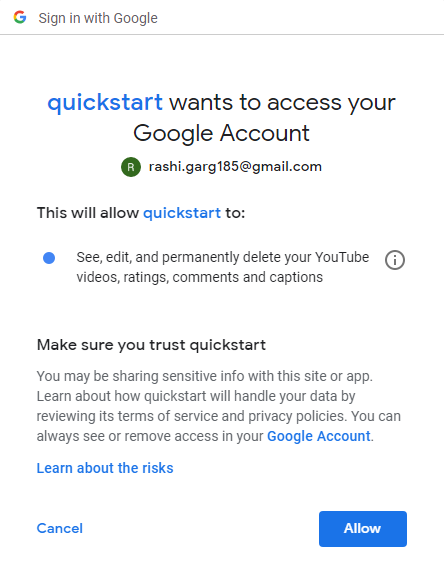Youtube 数据 API 播放列表 |第一组
在涵盖了所有类型的搜索和视频方法之后,我们将在本文中讨论有关播放列表的内容。每个人都必须知道 Youtube 中的播放列表是什么。使用 Youtube Data API 检索播放列表有两种方法:
- 检索所有播放列表
- 检索我的播放列表
我们将使用完整的代码和输出详细讨论这些方法。
按照以下步骤生成客户端 ID 和密钥。
- 转到 Google Google Developers Console,然后单击页面右上角的登录。使用有效 Google 帐户的凭据登录。如果您没有 google 帐户,请先设置一个帐户,然后使用详细信息在 Google Developers 主页上登录。
- 现在导航到开发人员仪表板并创建一个新项目。
- 单击启用 API 选项。
- 在搜索字段中,搜索Youtube Data API并选择下拉列表中的 Youtube Data API 选项。

- 您将被重定向到一个显示有关 Youtube Data API 的信息的屏幕,以及两个选项: ENABLE 和 TRY API 。
- 单击启用选项以开始使用 API。
- 在 APIs & Services 下的侧边栏中,选择Credentials 。
- 在页面顶部,选择OAuth 同意屏幕选项卡。选择一个电子邮件地址,输入产品名称(如果尚未设置),然后单击保存按钮。
- 在Credentials 选项卡中,选择 Create credentials 下拉列表,然后选择OAuth Client Id 。 OAuth 通常用于需要授权的情况,例如检索用户喜欢的视频。
- 选择应用类型Other,输入名称“YouTube Data API Myvideos”,点击Create按钮,点击OK。
- 单击客户端 ID 右侧的下载按钮以下载 JSON 文件。
- 将文件保存并重命名为 client_secret.json 并将其移动到工作目录。
使用pip命令安装其他库:
pip install --upgrade google-auth google-auth-oauthlib google-auth-httplib2注意:我们忘记讨论的一件事是如何找到频道 ID 以将其用作第一个代码中的参数 - 列出与 Youtube 频道 ID 关联的所有播放列表。
请按照以下步骤查找频道 ID:
- 登录您的 Youtube 帐户。
- 在左上角,单击三行图标并转到设置。

- 现在在左侧的同一菜单中,它将显示高级设置选项。

- 您将在Account Information下看到您的频道 ID。
检索所有播放列表的代码:此示例显示如何检索由参数列表中提到的频道标识的Youtube频道拥有的所有播放列表。
Python3
import os
import google.oauth2.credentials
import google_auth_oauthlib.flow
from googleapiclient.discovery import build
from googleapiclient.errors import HttpError
from google_auth_oauthlib.flow import InstalledAppFlow
# The CLIENT_SECRETS_FILE variable specifies the name of a file that contains
# client_id and client_secret.
CLIENT_SECRETS_FILE = "client_secret.json"
# This scope allows for full read/write
# access to the authenticated user's account
# and requires requests to use an SSL connection.
SCOPES = ['https://www.googleapis.com/auth/youtube.force-ssl']
API_SERVICE_NAME = 'youtube'
API_VERSION = 'v3'
def get_authenticated_service():
flow = InstalledAppFlow.from_client_secrets_file(CLIENT_SECRETS_FILE, SCOPES)
credentials = flow.run_console()
return build(API_SERVICE_NAME, API_VERSION, credentials = credentials)
def print_response(response):
print(response)
# Build a resource based on a list of
# properties given as key-value pairs.
# Leave properties with empty values out
# of the inserted resource.
def build_resource(properties):
resource = {}
for p in properties:
# Given a key like "snippet.title", split into
# "snippet" and "title", where
# "snippet" will be an object and "title"
# will be a property in that object.
prop_array = p.split('.')
ref = resource
for pa in range(0, len(prop_array)):
is_array = False
key = prop_array[pa]
# For properties that have array values,
# convert a name like "snippet.tags[]" to
# snippet.tags, and set a flag to handle
# the value as an array.
if key[-2:] == '[]':
key = key[0:len(key)-2:]
is_array = True
if pa == (len(prop_array) - 1):
# Leave properties without values
# out of inserted resource.
if properties[p]:
if is_array:
ref[key] = properties[p].split(', ')
else:
ref[key] = properties[p]
elif key not in ref:
# For example, the property is "snippet.title", but the resource does
# not yet have a "snippet" object. Create the snippet object here.
# Setting "ref = ref[key]" means that in the next time through the
# "for pa in range ..." loop, we will be setting a property in the
# resource's "snippet" object.
ref[key] = {}
ref = ref[key]
else:
# For example, the property is "snippet.description",
# and the resource already has a "snippet" object.
ref = ref[key]
return resource
# Remove keyword arguments that are not set
def remove_empty_kwargs(**kwargs):
good_kwargs = {}
if kwargs is not None:
for key, value in kwargs.items():
if value:
good_kwargs[key] = value
return good_kwargs
def playlists_list_by_channel_id(client, **kwargs):
kwargs = remove_empty_kwargs(**kwargs)
response = client.playlists().list(*kwargs).execute()
return print_response(response)
if __name__ == '__main__':
# When running locally, disable OAuthlib's
# HTTPs verification. When running in production
# * do not * leave this option enabled.
os.environ['OAUTHLIB_INSECURE_TRANSPORT'] = '1'
client = get_authenticated_service()
playlists_list_by_channel_id(client,
part ='snippet, contentDetails',
# Replace with your Youtube Channel Id
channelId ='UCqoMU8lNdUq63ZmTJFd620b',
maxResults = 25)Python3
import os
import google.oauth2.credentials
import google_auth_oauthlib.flow
from googleapiclient.discovery import build
from googleapiclient.errors import HttpError
from google_auth_oauthlib.flow import InstalledAppFlow
# The CLIENT_SECRETS_FILE variable specifies
# the name of a file that contains
# client_id and client_secret.
CLIENT_SECRETS_FILE = "client_secret.json"
# This scope allows for full read/write
# access to the authenticated user's account
# and requires requests to use an SSL connection.
SCOPES = ['https://www.googleapis.com/auth/youtube.force-ssl']
API_SERVICE_NAME = 'youtube'
API_VERSION = 'v3'
def get_authenticated_service():
flow = InstalledAppFlow.from_client_secrets_file(
CLIENT_SECRETS_FILE, SCOPES)
credentials = flow.run_console()
return build(API_SERVICE_NAME, API_VERSION, credentials = credentials)
def print_response(response):
print(response)
# Build a resource based on a list of
# properties given as key-value pairs.
# Leave properties with empty values
# out of the inserted resource.
def build_resource(properties):
resource = {}
for p in properties:
# Given a key like "snippet.title", split
# into "snippet" and "title", where
# "snippet" will be an object and "title"
# will be a property in that object.
prop_array = p.split('.')
ref = resource
for pa in range(0, len(prop_array)):
is_array = False
key = prop_array[pa]
# For properties that have array values, convert a name like
# "snippet.tags[]" to snippet.tags, and set a flag to handle
# the value as an array.
if key[-2:] == '[]':
key = key[0:len(key)-2:]
is_array = True
if pa == (len(prop_array) - 1):
# Leave properties without values out of inserted resource.
if properties[p]:
if is_array:
ref[key] = properties[p].split(', ')
else:
ref[key] = properties[p]
elif key not in ref:
# For example, the property is "snippet.title",
# but the resource does not yet have a "snippet"
# object. Create the snippet object here.
# Setting "ref = ref[key]" means that in the
# next time through the "for pa in range ..." loop,
# we will be setting a property in the
# resource's "snippet" object.
ref[key] = {}
ref = ref[key]
else:
# For example, the property is
# "snippet.description", and the resource
# already has a "snippet" object.
ref = ref[key]
return resource
# Remove keyword arguments that are not set
def remove_empty_kwargs(**kwargs):
good_kwargs = {}
if kwargs is not None:
for key, value in kwargs.items():
if value:
good_kwargs[key] = value
return good_kwargs
def playlists_mine(client, **kwargs):
kwargs = remove_empty_kwargs(**kwargs)
response = client.playlists().list(**kwargs).execute()
return print_response(response)
if __name__ == '__main__':
# When running locally, disable OAuthlib's
# HTTPs verification. When
# running in production * do not *
# leave this option enabled.
os.environ['OAUTHLIB_INSECURE_TRANSPORT'] = '1'
client = get_authenticated_service()
playlists_mine(client,
part ='snippet, contentDetails',
mine = True,
maxResults = 10,
onBehalfOfContentOwner ='',
onBehalfOfContentOwnerChannel ='')输出:
当您将执行代码时,您将被要求提供授权代码。要获取代码,您需要按照行上方命令提示屏幕中提到的链接:输入授权码。

现在点击链接并复制粘贴您将通过授予权限获得的授权代码。


列出我的播放列表的代码:此示例显示如何打印授权用户的播放列表。它使用我的参数来显示 API 应该只打印来自授权请求的用户的 Youtube 频道的播放列表。
Python3
import os
import google.oauth2.credentials
import google_auth_oauthlib.flow
from googleapiclient.discovery import build
from googleapiclient.errors import HttpError
from google_auth_oauthlib.flow import InstalledAppFlow
# The CLIENT_SECRETS_FILE variable specifies
# the name of a file that contains
# client_id and client_secret.
CLIENT_SECRETS_FILE = "client_secret.json"
# This scope allows for full read/write
# access to the authenticated user's account
# and requires requests to use an SSL connection.
SCOPES = ['https://www.googleapis.com/auth/youtube.force-ssl']
API_SERVICE_NAME = 'youtube'
API_VERSION = 'v3'
def get_authenticated_service():
flow = InstalledAppFlow.from_client_secrets_file(
CLIENT_SECRETS_FILE, SCOPES)
credentials = flow.run_console()
return build(API_SERVICE_NAME, API_VERSION, credentials = credentials)
def print_response(response):
print(response)
# Build a resource based on a list of
# properties given as key-value pairs.
# Leave properties with empty values
# out of the inserted resource.
def build_resource(properties):
resource = {}
for p in properties:
# Given a key like "snippet.title", split
# into "snippet" and "title", where
# "snippet" will be an object and "title"
# will be a property in that object.
prop_array = p.split('.')
ref = resource
for pa in range(0, len(prop_array)):
is_array = False
key = prop_array[pa]
# For properties that have array values, convert a name like
# "snippet.tags[]" to snippet.tags, and set a flag to handle
# the value as an array.
if key[-2:] == '[]':
key = key[0:len(key)-2:]
is_array = True
if pa == (len(prop_array) - 1):
# Leave properties without values out of inserted resource.
if properties[p]:
if is_array:
ref[key] = properties[p].split(', ')
else:
ref[key] = properties[p]
elif key not in ref:
# For example, the property is "snippet.title",
# but the resource does not yet have a "snippet"
# object. Create the snippet object here.
# Setting "ref = ref[key]" means that in the
# next time through the "for pa in range ..." loop,
# we will be setting a property in the
# resource's "snippet" object.
ref[key] = {}
ref = ref[key]
else:
# For example, the property is
# "snippet.description", and the resource
# already has a "snippet" object.
ref = ref[key]
return resource
# Remove keyword arguments that are not set
def remove_empty_kwargs(**kwargs):
good_kwargs = {}
if kwargs is not None:
for key, value in kwargs.items():
if value:
good_kwargs[key] = value
return good_kwargs
def playlists_mine(client, **kwargs):
kwargs = remove_empty_kwargs(**kwargs)
response = client.playlists().list(**kwargs).execute()
return print_response(response)
if __name__ == '__main__':
# When running locally, disable OAuthlib's
# HTTPs verification. When
# running in production * do not *
# leave this option enabled.
os.environ['OAUTHLIB_INSECURE_TRANSPORT'] = '1'
client = get_authenticated_service()
playlists_mine(client,
part ='snippet, contentDetails',
mine = True,
maxResults = 10,
onBehalfOfContentOwner ='',
onBehalfOfContentOwnerChannel ='')
输出:
当您将执行代码时,您将被要求提供授权代码。要获取代码,您需要按照行上方命令提示屏幕中提到的链接:输入授权码。

现在点击链接并复制粘贴您将通过授予权限获得的授权代码。


从输出中可以看出,授权用户的帐户中有 2 个播放列表,即在我的帐户中有两个播放列表。从总结果参数可以看出这一点。通过分析输出,您还可以找到播放列表 ID,即与每个播放列表相关联的唯一标识。
注意:请参阅与 Playlist.list() 方法关联的完整属性列表。随意尝试使用不同的属性值。
参考:
- https://developers.google.com/youtube/v3/docs/playlists/list
- https://support.google.com/youtube/answer/3250431?hl=en